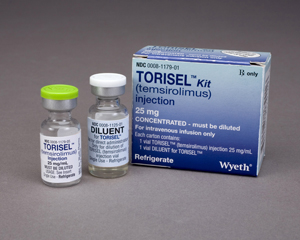Product
Torisel
Approval Date
May 30, 2007
Release Date
November 15, 2007
Companies
Wyeth
Class
Antineoplastic (mTOR kinase inhibitor)
Indication
Advanced renal cell carcinoma.
Active Ingredient
Temsirolimus 25mg/mL; ethanolic soln for IV infusion aftertwo dilutions (first w. supplied diluent); contains alcohol, polysorbate 80.
Agency Roster
Saatchi & Saatchi Healthcare Innovations (professional)
Avenue A|Razorfish (interactive)
MarketingStrategy/Execution
Wyeth’s Torisel, approved for treating a type of advancedkidney cancer, is entering a crowded market. Predecessors include the likes ofBayer/Onyx’s Nexavar (sorafenib) and Pfizer’s Sutent (sunitinib). Analysts saythis could limit Torisel’s market potential, although future indications couldspur growth. Advertising creative will have to distinguish the product and could play up the fact that Torisel is the only product for RCC actually proven to lengthen survival. The point of differentation will be its unique mechanism ofaction, called mTOR inhibition. Messaging may highlight overall survival data, in addition to a good side effect profile.
The Market
| Antineo enzyme recept inh US sales ($000s) last 5 years | |
| 2006 | $1,109,103 |
| 2005 | $797,125 |
| 2004 | $637,574 |
| 2003 | $433,305 |
| 2002 | $244,373 |
| Source: IMS Health, Nov. 2007 |
|
| Top 5 antineo enzyme recept inh | ||
| Jan.-Sept. ’07 US sales ($000s) | % sales growth over Jan.-Sept. ‘06 | |
| GLEEVEC(Novartis) | $597,893 | 14% |
| SUTENT(Pfizer) | $207,624 | 129% |
| VELCADE(Millennium) | $197,359 | 17% |
| SPRYCEL(Bristol-Myers Squibb) | $42,801 | 479% |
| NEXAVAR(Bayer/Onyx) | $10,161 | 5% |
| Source: IMS Health, Nov. 2007 |
||
Physician Outlook
Torisel (temsirolimus), is the first market entrant in a newclass of anticancer agents known as mTOR inhibitors. Torisel acts by inhibitingmTOR, which controls cell division. Torisel was approved in May for treatmentof advanced renal cell carcinoma (RCC). RCC accounts for about 85% all cases ofkidney cancer. Torisel’s approval was based on a Phase III clinical trialshowing a significant improvement in overall survival among poor prognosispatients with metastatic RCC who received it in front-line therapy. Torisel is administered intravenously(preferred by many oncologists) and works by a different mechanism of actionversus Nexavar and Sutent, two new oral brands also available for treatingadvanced RCC. Like these other brands, Torisel received a broad label for“advanced” RCC, even though its survival data is based on severely illpatients. As a result, the market foradvanced RCC will become increasingly competitive. Torisel is also beingevaluated in other malignancies, including mantle cell lymphoma.
—Bill Bowman, JD, VP, Category Leader, Oncology, GfK MarketMeasures, November 2007
Also in the Pipeline(according to Adis R&D Insight)
Drug: AP 23573/MK8669
Manufacturer: ARIAD/Merck
Indication:Sarcoma
Active ingredient: Deforolimus
Phase: III
Drug: Torisel
Manufacturer: Wyeth
Indication:Non-Hodgkins lymphoma
Active ingredient: Temsirolimus
Phase: III
Source: Wolters Kluwer Health, Nov. 2007
Recent MM&MCoverage
Wyeth’sTorisel Enters Crowded Market
ProductNews from the 04/10/07 News Brief
Pharmacology
Temsirolimus binds to an intracellular protein, and theresulting protein-drug complex inhibits the activity of an intracellular targetcalled mTOR kinase, a cellular enzyme that regulates cell proliferation, cellgrowth and cell survival. In vitro studies show that inhibiting mTOR interfereswith the translation of genes that regulate the cell cycle. It also resulted inreduced levels of certain cell growth factors involved in the development ofnew blood vessels, such as vascular endothelial growth factor.
Clinical Trials
In a study conducted in 626 previously untreated patientswith advanced renal cell carcinoma, treatment with temsirolimus was compared totemsirolimus + interferon-a and to interferon-a alone. There was astatistically significant improvement in overall survival in the patients giventemsirolimus (10.9 months) compared to those given interferon-a (7.3 months).
Adverse Reactions
Rash, asthenia, mucositis, nausea, edema, anorexia, infection,pain, anemia, hyperglycemia, hyperlipemia, hypertriglyceridemia, elevatedalkaline phosphatase, elevated serum creatinine, lymphopenia, hypophosphatemia,thrombocytopenia, elevated AST, leukopenia; hypersensitivity/infusion reactions(anaphylaxis, dyspnea, flushing, chest pain), immunosuppression, interstitiallung disease, bowel perforation, acute renal failure, abnormal wound healing;others (see literature).
Adults
25mg once weekly. Infuse IV over 30–60min, using an infusionpump. Continue until disease progression or unacceptable toxicity occurs.Premedicate with IV antihistamine (eg, diphenydramine). Hold dose if ANC<1000/mm3, platelets <75000/mm3, or NCI CTCAE=grade 3 adverse reaction occurs; may restart at a dose reduced by 5mg/week (nolower than 15mg/wk) if adverse reactions resolve to =grade 2. See Interactions.
Children
Not recommended.
Precautions
Sirolimus or related allergy. Hepatic insufficiency.Perioperative period (may interfere with wound healing). CNS tumors. MonitorCBCs weekly and chemistry panels every 2 weeks, blood glucose, lipids, renalfunction, and for worsening respiratory or GI symptoms (eg, acute abdomen,blood in stool). Elderly. Pregnancy (Cat.D) (avoid pregnancy during and for 3months after therapy, male patients should use appropriate contraception),nursing mothers: not recommended.
Interactions
Avoid strong CYP3A4 inhibitors (eg, ketoconazole,itraconazole, clarithromycin, atazanavir, indinavir, nefazodone, nelfinavir,ritonavir, saquinavir, telithromycin, voriconazole, grapefruit juice); if used,consider reducing temsirolimus dose to 12.5mg/week (allow 1 week afterdiscontinuing CYP3A4 inhibitor before readjusting temsirolimus dose). Avoidstrong CYP3A4 inducers (eg, dexamethasone, phenytoin, carbamazepine, rifampin,rifabutin, rifampicin, phenobarbital, St. John’s Wort); if used, consider increasingtemsirolimus dose to 50mg/week. Avoid live vaccines, close contact withvaccinees. Additive toxicity with sunitinib (rash, gout/cellulitis),anticoagulants (intracerebral bleeding).









